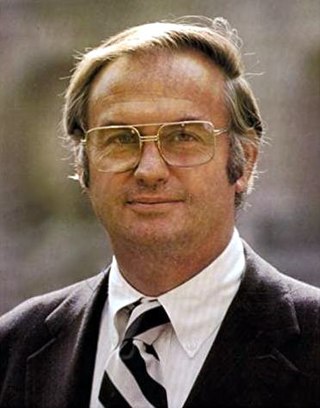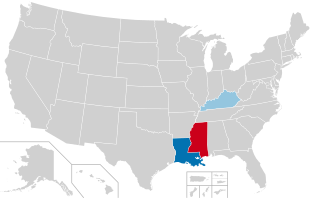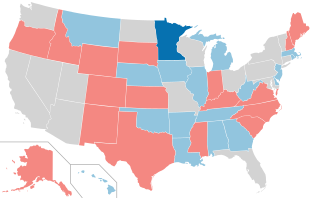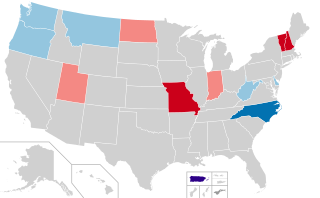
Lowell Palmer Weicker Jr. was an American politician who served as a U.S. Representative, U.S. Senator, and the 85th Governor of Connecticut.

United States gubernatorial elections were held on November 2, 2004, in 11 states and two territories. There was no net gain in seats for either party, as Democrats picked up an open seat in Montana while defeating incumbent Craig Benson in New Hampshire, while Republicans defeated incumbent Joe Kernan in Indiana and won Missouri after Bob Holden lost in the primary. These elections coincided with the presidential election.

The 1962 United States Senate elections was an election for the United States Senate. Held on November 6, the 34 seats of Class 3 were contested in regular elections. Special elections were also held to fill vacancies. They occurred in the middle of President John F. Kennedy's term. His Democratic Party made a net gain of four seats from the Republicans, increasing their control of the Senate to 68-32. However, this was reduced to 67-33 between the election and the next Congress, as on November 18, 1962, Democrat Dennis Chávez, who was not up for election that year, died. He was replaced on November 30, 1962, by Republican appointee Edwin L. Mechem. Additionally, Democrat Strom Thurmond became a Republican in 1964, further reducing Democrats to 66-34. This was the first time since 1932 that Democrats gained seats in this class of Senators.

The 1944 United States Senate elections coincided with the re-election of Franklin D. Roosevelt to his fourth term as president. The 32 seats of Class 3 were contested in regular elections, and three special elections were held to fill vacancies.

The 1990 United States House of Representatives elections was an election for the United States House of Representatives on November 6, 1990, to elect members to serve in the 102nd United States Congress. They occurred in the middle of President George H. W. Bush's term. As in most midterm elections, the President's Republican Party lost seats to the Democratic Party, slightly increasing the Democratic majority in the chamber. It was a rare instance, however, in which both major parties lost votes to third parties such as the Libertarian Party as well as independent candidates.

United States gubernatorial elections were held on November 7, 2006, in 36 states and two territories. The elections coincided with the midterm elections of the United States Senate and the United States House of Representatives.

United States gubernatorial elections were held on November 5, 2002, in 36 states and two territories. The Republicans won eight seats previously held by the Democrats, as well as the seat previously held by Minnesota governor Jesse Ventura, who was elected on the Reform Party ticket but had since renounced his party affiliation. The Democrats won 10 seats previously held by the Republicans, as well as the seat previously held by Maine governor Angus King, an independent. The elections were held concurrently with the other United States elections of 2002.

United States gubernatorial elections were held on November 3, 1998, in 36 states and two territories. Going into the election, 24 of the seats were held by Republicans, 11 by Democrats, and one by an Independent. The elections changed the national balance of power by the loss of one Republican and the gain of one Independent, although political party dominance was shifted in nine states. Democrats gained open seats in California and Iowa and defeated incumbents Fob James of Alabama and David Beasley of South Carolina, while Republicans won open seats in Colorado, Florida, Nebraska, and Nevada and the Reform Party won an open Republican governorship in Minnesota. By the end of the election, 23 seats were held by Republicans, 11 by Democrats, one by the Reform Party, and one by an Independent.

United States gubernatorial elections were held on November 7, 2000, in 11 states and two territories. The elections coincided with the presidential election. Democrats gained one seat by defeating an incumbent in West Virginia. As of 2023, this remains the last gubernatorial cycle in which a Democrat won in Indiana.

United States gubernatorial elections were held on November 5, 1996, in 11 states and two territories. Going into the elections, seven of the seats were held by Democrats and four by Republicans. Democrats picked up the open seat in New Hampshire, and Republicans picked up the open seat in West Virginia, for no net change in the partisan balance of power. These elections coincided with the presidential election.

United States gubernatorial elections were held on November 5, 1991, in three states and one territory. Prior to the elections, Democrats held two seats and Republicans held one. The national balance of power did not change as a result of the elections, but the balance of power shifted in two states.

United States gubernatorial elections were held on November 3, 1992, in 12 states and two territories. Going into the elections, six of the seats were held by Democrats and six by Republicans. After the elections, eight seats were held by Democrats and four by Republicans. The elections coincided with the presidential election.

United States gubernatorial elections were held on November 8, 1994, in 36 states and two territories. Many seats held by Democratic governors switched to the Republicans during the time known as the Republican Revolution. Indeed, this would be the first election since 1969 that Republicans won the majority of governorships.

The 1994 Alaska gubernatorial election took place on November 8, 1994, for the post of Governor of Alaska, United States. Democratic candidate Tony Knowles narrowly defeated Republican candidate Jim Campbell and Lieutenant Governor Jack Coghill of the Alaskan Independence Party. In the Republican Revolution year of the 1994 elections, Alaska's was the only governor's seat in the country to switch from Republican to Democratic.

Elections in Vermont are authorized under Chapter II of the Vermont State Constitution, articles 43–49, which establishes elections for the state level officers, cabinet, and legislature. Articles 50–53 establish the election of county-level officers.

The 1990 Connecticut gubernatorial election included a three-way race for a seat left open when Governor William A. O'Neill declined to run for re-election. A Connecticut Party nominee Lowell Weicker narrowly won the election, becoming the first candidate who was not a member of one of the two major parties to win a gubernatorial election since the 1974 election in Maine.

The 1990 United States elections were held on November 6 and elected the members of the 102nd United States Congress. The elections occurred in the middle of Republican President George H. W. Bush's term and during the Gulf War. The Democratic Party slightly built on their control of Congress.

United States gubernatorial elections were held on November 8, 2016, in 12 states and two territories. The last regular gubernatorial elections for nine of the 12 states took place in 2012. The last gubernatorial elections for New Hampshire, Oregon, and Vermont took place in 2014, as Oregon held a special election due to the resignation of Governor John Kitzhaber, while the governors of New Hampshire and Vermont both serve two-year terms. The 2016 gubernatorial elections took place concurrently with several other federal, state, and local elections, including the presidential election, Senate, and House elections.

United States gubernatorial elections were held on November 3, 2020, in 11 states and two territories. The previous gubernatorial elections for this group of states took place in 2016, except in New Hampshire and Vermont where governors only serve two-year terms. These two states elected their current governors in 2018. Nine state governors ran for reelection and all nine won, while Democrat Steve Bullock of Montana could not run again due to term limits and Republican Gary Herbert of Utah decided to retire at the end of his term.

United States gubernatorial elections were held on November 8, 2022, in 36 states and three territories. As most governors serve four-year terms, the last regular gubernatorial elections for all but two of the seats took place in 2018 U.S. gubernatorial elections. The gubernatorial elections took place concurrently with several other federal, state, and local elections, as part of the 2022 midterm elections.




















